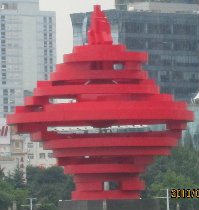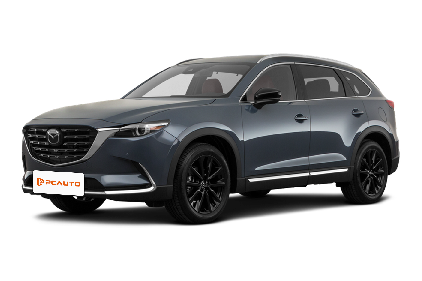Q
Is CX-9 a large SUV?
The Mazda CX-9 truly falls into the category of large SUVs. Its body length exceeds 5 meters, and the wheelbase is close to 2.9 meters. It offers a three-row, seven-seat layout, meeting the space standards of large SUVs, which is very suitable for the long-distance travel or weekend self-driving needs of large Malaysian families. In terms of power, the CX-9 is equipped with a 2.5-liter turbocharged engine, which balances power output and fuel economy. Paired with Mazda's signature GVC (G-Vectoring Control) system, it can provide a more stable driving experience. It's worth mentioning that although the CX-9 is positioned as a large SUV, its Kodo design language gives it a more dynamic appearance, not as bulky as traditional large SUVs. For Malaysian consumers, if they focus more on space practicality, they can also consider models in the same class such as the Toyota Fortuner or the Mitsubishi Outlander. They also offer three-row seats, but each has its own characteristics in terms of driving quality. When buying a large SUV, it is recommended that consumers consider parking convenience according to their own needs, as such models may be a bit inconvenient on the narrow roads or in the compact parking lots of some old urban areas in Malaysia.
Special Disclaimer: This content is published by users and does not represent the views or position of PCauto.
Related Q&A
Q
Is the CX-9 fast?
The Mazda CX-9 is a large SUV with decent power performance in the Malaysian market. It's equipped with a 2.5-liter turbocharged engine, which outputs 227 horsepower and 420 Nm of torque. Paired with a 6-speed automatic transmission, the power output is smooth and sufficient to meet the needs of daily driving and high-speed overtaking. The 0 - 100 km/h acceleration takes about 8 seconds, which is relatively fast for a 7-seater family SUV. Although the acceleration performance of the CX-9 can't compare with that of performance SUVs, it's above average in its class. Especially, it has strong mid-range acceleration ability, making it suitable for driving on Malaysian highways. It's worth noting that the CX-9 uses Mazda's Skyactiv technology, which balances power and fuel economy. This is a good trade - off for Malaysian consumers. If you're after more powerful performance, you can consider some competitors with V6 engines. However, the CX-9 strikes a great balance between power, space, and fuel consumption, making it particularly suitable for Malaysian family users.
Q
How big is a CX-9 gas tank?
The fuel tank capacity of the Mazda CX-9 is 72.5 liters. This design can meet the needs of family long-distance trips, reducing the inconvenience of frequent refueling. For users in Malaysia, such a fuel tank size can provide good cruising range while taking fuel economy into account, which is especially practical when traveling across states or on self-driving tours. As a mid-to large-sized SUV, the CX-9 is equipped with an efficient power system. The fuel tank volume matches the fuel consumption performance of its 2.5-liter turbocharged engine, ensuring a reasonable driving range under comprehensive road conditions.
In addition, it is recommended that car owners regularly check the condition of the fuel tank and the oil circuit system and maintain good driving habits, such as smooth acceleration and reasonable use of cruise control, to further improve fuel efficiency. At the same time, pay attention to avoid exposing the fuel tank to the sun for a long time in Malaysia's hot climate, so as not to affect fuel evaporation and system safety.
Q
How many km per liter is a Mazda CX-9?
According to official data, the fuel economy of the Mazda CX 9 is roughly between 10 and 12 kilometers per liter of gasoline. The exact figure depends on driving conditions, road conditions, and vehicle configuration. For instance, the fuel consumption of the 2.5-liter turbocharged engine paired with a four-wheel-drive system is slightly higher than that of the front-wheel-drive version. In Malaysia, heavy traffic in the city may lead to higher fuel consumption, while driving on the highway can get closer to the ideal figure. Mazda's Skyactiv technology enhances fuel economy by optimizing engine efficiency and lightening the vehicle body, while maintaining power output. For consumers who are concerned about fuel consumption, it is recommended to regularly maintain tire pressure and engine condition and avoid aggressive driving. These habits can significantly affect the actual fuel-consumption performance. When compared with other SUVs in the same class, the CX-9's fuel consumption is at a medium level, but its handling and interior quality are still outstanding advantages, making it suitable for family users who pursue a great driving experience.
Q
How many kilometers can a Mazda CX-9 do?
As a mid-large SUV, the durability and mileage performance of the Mazda CX-9 mainly depend on daily maintenance and driving habits. Under normal use and regular maintenance, the CX-9 can reach a mileage of 200,000 to 300,000 kilometers or even more. Many owners have reported that the vehicle can maintain stable performance in the long run with good maintenance.
For users in Malaysia, the hot and humid climate may have a certain impact on vehicle components such as rubber seals and batteries. It is recommended to regularly check the cooling system and air-conditioning system, and replace the engine oil and filters according to the manufacturer's recommended maintenance schedule to extend the engine life.
The Skyactiv-G turbocharged engine equipped in the CX-9 has mature technology, and it performs well in terms of fuel economy and reliability, making it suitable for long-distance family trips. In addition, the rainy weather in Malaysia places certain requirements on the braking system and chassis anti-rust. It is recommended to regularly clean the chassis and check the thickness of the brake pads.
If you want to learn more about specific maintenance details, you can refer to the maintenance manual provided by Mazda Malaysia official or consult the authorized service center.
Q
What is the fuel consumption per 100km of the Mazda CX-9?
According to official data, the combined fuel consumption of the Mazda CX-9 in the Malaysian market is approximately 8.5 to 9.5 liters per 100 kilometers. The specific figure depends on driving habits, road conditions, and vehicle configuration. For example, the 2.5-liter turbocharged engine equipped in the vehicle has better fuel-consumption performance during high-speed cruising, while it will be slightly higher in congested urban areas. Malaysian car owners can refer to this data as a benchmark for their daily driving. At the same time, it is recommended to carry out regular vehicle maintenance, such as keeping the tire pressure normal and using the appropriate engine oil. These details can all help to optimize fuel economy.
In addition, Mazda's Skyactiv technology, with its efficient power system and lightweight design, provides ample power while also taking fuel-consumption performance into account. It is suitable for family users who value both the driving experience and practicality. If you have higher requirements for fuel consumption, you can also consider hybrid or pure-electric models. However, as a seven-seat SUV, the CX-9's fuel-consumption level is still competitive in its class.
Q
How long will a Mazda CX-9 last?
As a mid-large SUV designed mainly for family use, the Mazda CX-9 typically shows a durability of 150,000 to 200,000 kilometers or even more in the Malaysian market. The actual lifespan depends on the owner's maintenance habits and driving environment. Regularly changing engine oil, transmission fluid, maintaining the braking system and following the manufacturer's recommended maintenance schedule are the key factors. The hot and humid climate in Malaysia may have a certain impact on rubber components and electronic systems. It is recommended that car owners pay special attention to the inspection of the air-conditioning system and chassis parts.
The 2.5T turbocharged engine equipped in the CX-9 has mature technology and is paired with a 6-speed automatic transmission. The reliability of the powertrain has been verified by the market. However, for turbocharged models, more attention should be paid to the maintenance of the cooling system and intake system. When using this kind of large SUV in Malaysia, car owners also need to regularly clean the radiator to prevent overheating problems in the tropical climate, and choose regular gas stations to ensure fuel quality. If properly maintained, the CX-9 can fully meet the needs of Malaysian families for more than 10 years. Its relatively high resale value also reflects the market's recognition of its durability.
Q
What is the death rate of a Mazda CX-9?
Regarding the mortality data of the Mazda CX-9, the Malaysian official has not released the statistics on the traffic accident mortality rate of specific vehicle models. However, according to reports from multiple global safety evaluation institutions, the Mazda CX-9 performs excellently in terms of safety performance. For example, it has won the highest rating of "Top Safety Pick+" multiple times in the crash tests of the Insurance Institute for Highway Safety (IIHS) in the United States. This is due to its high-rigidity body structure, a well-developed airbag system, and advanced active safety technologies such as intelligent brake assist and lane-keeping assist.
For Malaysian consumers, when choosing an SUV, besides paying attention to safety ratings, they also need to consider local road conditions and driving habits. For instance, the G-Vectoring Control technology equipped in the CX-9 can improve handling stability on slippery roads. Regular maintenance and proper use of safety features (such as child seat interfaces) can further reduce risks.
It's worth noting that the mortality rate of any vehicle is closely related to factors such as driving behavior and road environment. Therefore, safety driving awareness and compliance with traffic rules are of crucial importance.
Q
Is CX-9 fuel efficient?
As a mid - large SUV, the Mazda CX-9 has above-average fuel efficiency among vehicles in the same class. The 2.5-liter turbocharged engine it's equipped with, combined with Skyactiv technology, not only provides sufficient power but also achieves relatively reasonable fuel consumption through optimized combustion efficiency and gearbox tuning. According to actual driving conditions, the combined fuel consumption is approximately 10 to 12 liters per 100 kilometers. For Malaysian users, although the fuel consumption of the CX-9 may be slightly higher than that of compact SUVs, considering its spacious interior and strong power output, such performance is still acceptable. If you focus more on fuel economy, you can consider hybrid models or diesel versions. However, the balance between performance and practicality of the CX-9 is still worth considering. Especially during family trips or long-distance drives, its comfort and safety can also offer a great experience.
Q
Do Mazda CX-9 hold their value?
The Mazda CX - 9's performance in terms of value retention in the Malaysian used-car market is above average. Its resale value is influenced by the brand's reputation, the vehicle's model positioning, and market demand. As an imported seven-seat SUV, the CX-9 has gained stable recognition among local middle-and high-end family users thanks to its KODO design language, SKYACTIV technology, and luxurious interior configuration. In particular, the post-2017 facelifted models are more popular as they have upgraded safety features like the i-ACTIVSENSE system.
However, its resale value is slightly lower than that of non-luxury brand hardcore SUVs such as the Toyota Fortuner. This is mainly because the latter has a larger market presence in Southeast Asia and lower maintenance costs. Nevertheless, the CX-9 can still maintain a relatively stable used-car price due to its more refined design and driving experience. Typically, a three-year-old CX-9 can retain about 60-65% of its original value.
It's worth noting that Malaysian consumers generally pay close attention to the maintenance records and original warranty status when purchasing a used CX-9. It is recommended to give priority to vehicles serviced at Mazda-authorized dealerships to safeguard their subsequent resale value. At the same time, one should be aware of the longer supply cycle of imported car parts. Regular maintenance and complete repair records can significantly increase the premium of a used car.
Q
Which country made Mazda CX-9?
The Mazda CX-9 is an SUV model designed and produced by the Japanese automaker Mazda. It is mainly targeted at the global market, including Malaysia. This vehicle is manufactured at Mazda's factory in Hiroshima, Japan, and it adopts the brand's latest KODO design language and Skyactiv technology, emphasizing the combination of a dynamic exterior and efficient power performance.
The CX-9 is quite popular in the Malaysian market. Thanks to its spacious three - row seat layout and luxurious interior configuration, it is suitable for family users. As a Japanese brand, Mazda has always focused on the driving experience and fuel economy. The 2.5-liter turbocharged engine equipped in the CX-9 not only provides ample power but also takes environmental protection performance into account.
For Malaysian consumers, the CX-9 is an imported SUV that combines practicality and brand reputation. Its Japanese manufacturing background also adds a guarantee of quality. Meanwhile, Mazda has a relatively complete dealer network and after-sales service system in Malaysia, which makes it convenient for car owners to carry out maintenance.
Latest Q&A
Q
Toyota Corolla Cross how many seats
The Toyota Corolla Cross hits the Malaysian market as a 5-seater, featuring the standard 2+3 seating layout that's perfect for everyday family trips. True to the Corolla lineage's practical roots, the rear seats split 60:40 and fold down, letting you flexibly expand cargo space to 440 liters (for the hybrid) or 487 liters (for the petrol variant) – ideal if you regularly haul more gear.
Safety is a big win here, with Toyota Safety Sense comes standard across the range. That means you get active safety tech like pre-collision warning and lane departure alert, which really speaks to how Malaysian buyers prioritize peace of mind on the road.
Under the hood, you've got two solid choices: a 1.8L petrol engine or a 1.8L hybrid. The hybrid, in particular, is a fuel-sipper – Toyota claims around 3.8L/100km – so if fuel economy is a top concern, that's the one to watch.
Riding 161mm off the ground, it sits a touch higher than your average sedan, which helps tackle those rough patches of road you sometimes find around Malaysia. But don't worry, it still keeps that car-like handling comfort you'd expect. Yep, this is urban SUV design done right.
Q
how much is Isuzu MU-X
In the current Malaysian market, the Isuzu MU-X ranges roughly from RM 169,000 to RM 208,000, depending on the variant and specs. Keep in mind, actual prices might shift a bit with dealer promotions or optional extras, so your best bet is to hit up your nearest authorized Isuzu dealer for the latest numbers.
As a 7-seater SUV, the MU-X has built a solid rep for its tough chassis and reliable diesel heart. Under the hood, you'll find the 3.0L Blue Power turbo diesel engine, which dishes out great low-end torque and impressive fuel economy—perfect for Malaysian families tackling long highway drives or the occasional light off-road adventure.
Safety hasn't been skimped on either, with features like electronic stability control, multiple airbags, and a reverse camera all part of the package. Inside, it's all about practicality: there's plenty of room for passengers, and the seats fold in all sorts of ways to juggle people and cargo.
One thing worth mentioning is that the MU-X holds its value pretty well in the used car market. That's probably down to Isuzu's strong reputation for durability, especially from their commercial vehicle roots. If your budget's a bit tight, a well-maintained second-hand MU-X could be a smart alternative to consider.
Q
Isuzu MU-X how many seats
The Isuzu MU-X is a popular 7-seater SUV in the Malaysian market, perfect for family trips or when you need to carry a crowd. It's got that classic 2+3+2 seating setup – fold down the second row and you'll free up more luggage space, while the third row works well for kids or adults on shorter rides. What really stands out about this SUV is its tough chassis and reliable diesel engine, which make it a solid performer for Malaysia's varied road conditions – whether you're cruising around the city or tackling some light off-roading, it handles it all with ease. Safety-wise, the MU-X doesn't skimp either, coming with features like electronic stability control and multiple airbags to keep everyone on board protected. For Malaysian buyers eyeing a 7-seater SUV, the MU-X is a practical and budget-friendly pick. It offers plenty of room for passengers, impressive fuel efficiency, and low maintenance costs – ideal for folks who need to balance family needs with everyday usability. Plus, Isuzu has a wide after-sales service network across Malaysia, which adds extra convenience for owners down the line.
Q
what type of vehicle is a toyota hilux
The Toyota Hilux is a globally renowned pickup truck, celebrated for its legendary durability, versatility, and robust off-road capabilities – making it a perfect fit for Malaysia's diverse road conditions and usage demands. As a midsize pickup, the Hilux isn't just your daily commuter; it seamlessly transitions to handle construction sites, farms, or outdoor adventures with ease. Its generous ground clearance and rugged chassis design solidify its status as the go-to choice for tackling rough terrain.
In the Malaysian market, the Hilux offers a range of powertrain options, including efficient diesel engines that strike an impressive balance between pulling power and fuel economy. It also comes loaded with advanced safety tech, like Toyota Safety Sense (TSS), giving drivers that extra peace of mind.
What's more, the Hilux is a blank canvas for customization. Many owners deck theirs out with tonneau covers, beefy off-road tires, or upgraded suspension setups to truly make it their own. It's got a massive presence on Malaysian roads, which means servicing is a breeze and the used car market is always buzzing. Whether it's for family duties or keeping a business moving, the Hilux has earned its reputation as a trusty workhorse. From city streets to backcountry trails, it just keeps proving why it's one of the benchmarks for pickup trucks in the hearts of Malaysian consumers.
Q
toyota hilux pakai minyak apa
For the Toyota Hilux in Malaysia, the go-to recommendation is diesel engine oil that meets API CK-4 or ACEA E9 specs, typically in a 15W-40 viscosity – especially if you're rolling with the 2.4L or 2.8L diesel mills. These oils are tough enough to keep your engine protected and durable even when it's working hard. If you're often driving in Malaysia's scorching heat or hauling heavy loads, stepping up to a full synthetic or semi-synthetic 15W-40 can really boost lubrication performance.
Now, for the newer Hilux models, some owners opt for 5W-30 low-viscosity oils to eke out better fuel economy – but here's the catch: make sure whatever 5W-30 you pick has Toyota's official stamp of approval.
Another non-negotiable? Regular oil and filter changes. Aim for every 10,000 km or 6 months, whichever comes first. Malaysia's hot and dusty conditions are brutal on oil, breaking it down faster than you might think. And if your Hilux is still under warranty? Play it safe with the factory-recommended oil to avoid any headaches with warranty claims.
Here's something to remember: when it comes to oil brands, the real differences lie in their additive packages and base oil quality. Don't just go for the cheapest option or fall for flashy ads – check the certification marks on the bottle. For diesels like the Hilux, oil's detergent-dispersant properties are a big deal. Good ones help keep carbon deposits in check and reduce the risk of clogging your particulate filter.
View MoreRelated News

Rumor: Toyota and Mazda collaborate to develop the next-generation MX-5 and GR86
AshleySep 30, 2025

MAZDA EZ-60 will be launched in China, and will be available in other global markets in 2026
RobertSep 30, 2025

CX-80 too large? Too expensive? Mazda also offers you the CX-60
WilliamSep 4, 2025

Mazda Malaysia Launches its Largest SUV, the CX-80, with a Price of RM331,610
Kevin WongSep 4, 2025

Mazda Australia stated that there are currently no plans to launch an electric version of the BT-50.
LienAug 28, 2025
View More


















Pros
Cons